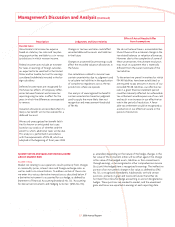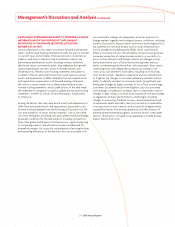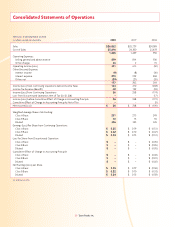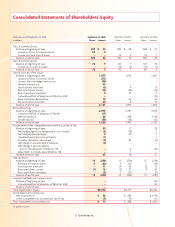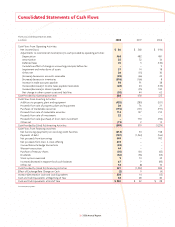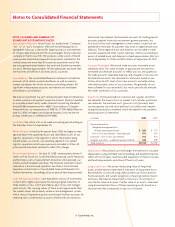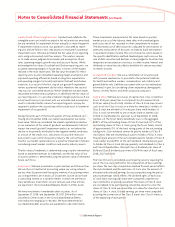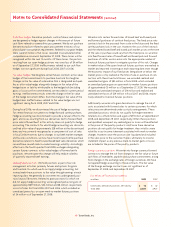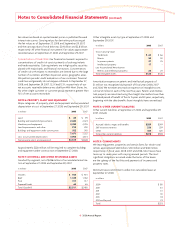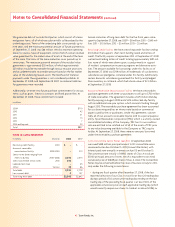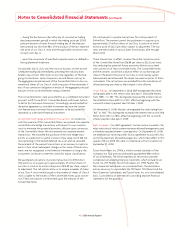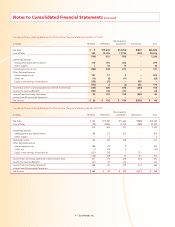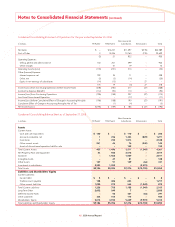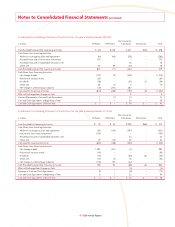Tyson Foods 2008 Annual Report Download - page 39
Download and view the complete annual report
Please find page 39 of the 2008 Tyson Foods annual report below. You can navigate through the pages in the report by either clicking on the pages listed below, or by using the keyword search tool below to find specific information within the annual report.
37 2008 Annual Report
Notes to Consolidated Financial Statements (continued)
than in the liability or mezzanine section between liabilities and
equity. SFAS No. 160 also requires consolidated net income be reported
at amounts that include the amounts attributable to both the parent
and the noncontrolling interest. The impact of SFAS No. 160 will not
have a material impact on our current Consolidated Financial State-
ments. SFAS No. 160 is effective for fi scal years, and interim periods
within those fi scal years, beginning on or after December 15, 2008;
therefore, we expect to adopt SFAS No. 160 at the beginning
of fi scal 2010.
In December 2007, the FASB issued Statement of Financial Account-
ing Standards No. 141R, “Business Combinations” (SFAS No. 141R). SFAS
No. 141R establishes principles and requirements for how an acquirer
in a business combination: 1) recognizes and measures in its fi nancial
statements identifi able assets acquired, liabilities assumed, and any
noncontrolling interest in the acquiree; 2) recognizes and measures
goodwill acquired in a business combination or a gain from a bargain
purchase; and 3) determines what information to disclose to enable
users of the fi nancial statements to evaluate the nature and fi nancial
effects of a business combination. SFAS No. 141R is effective for busi-
ness combinations for which the acquisition date is on or after the
beginning of the fi rst annual reporting period beginning on or after
December 15, 2008; therefore, we expect to adopt SFAS No. 141R for
any business combinations entered into beginning in fi scal 2010.
In March 2008, the FASB issued Statement of Financial Accounting
Standards No. 161, “Disclosures about Derivative Instruments and
Hedging Activities – an amendment of FASB Statement No. 133” (SFAS
No. 161). SFAS No. 161 establishes enhanced disclosure requirements
about: 1) how and why an entity uses derivative instruments; 2) how
derivative instruments and related hedged items are accounted for
under Statement 133 and its related interpretations; and 3) how deriva-
tive instruments and related hedged items affect an entity’s fi nancial
position, fi nancial performance and cash fl ows. SFAS No. 161 is effec-
tive for fi nancial statements issued for fi scal years and interim periods
beginning after November 15, 2008; therefore, we expect to adopt
SFAS No. 161 in the second quarter of fi scal 2009.
In May 2008, the FASB issued FASB Staff Position No. APB 14-1,
“Accounting for Convertible Debt Instruments That May Be Settled
in Cash upon Conversion (Including Partial Cash Settlement)” (FSP
APB 14-1). FSP APB 14-1 specifi es that issuers of convertible debt
instruments that may be settled in cash upon conversion (including
partial cash settlement) should separately account for the liability
and equity components in a manner that will refl ect the entity’s non-
convertible debt borrowing rate when interest cost is recognized in
subsequent periods. The amount allocated to the equity component
represents a discount to the debt, which is amortized into interest
expense using the effective interest method over the life of the debt.
FSP APB 14-1 is effective for fi nancial statements issued for fi scal
years beginning after December 15, 2008, and interim periods within
those fi scal years. Early adoption is not permitted. Therefore, we
expect to adopt the provisions of FSP APB 14-1 beginning in the fi rst
quarter of fi scal 2010. The provisions of FSP APB 14-1 are required to
be applied retrospectively to all periods presented. Upon retrospec-
tive adoption, we anticipate our effective interest rate on our 3.25%
Convertible Senior Notes due 2013 will range from 8.0% to 8.50%,
which would result in the recognition of an approximate $90 million
to $100 million discount to these notes with the offsetting after tax
amount recorded to capital in excess of par value. This discount will
be accreted until the maturity date at the effective interest rate, which
will not materially impact fi scal 2008 interest expense, but will result
in an estimated $15 million to $20 million increase to our fi scal 2009
interest expense.
NOTE 2: CHANGE IN ACCOUNTING PRINCIPLES
In June 2006, the Financial Accounting Standards Board (FASB) issued
Interpretation No. 48, “Accounting for Uncertainty in Income Taxes,”
an interpretation of FASB Statement No. 109 (FIN 48). FIN 48 pre-
scribes a recognition threshold and measurement attribute for the
fi nancial statement recognition and measurement of a tax position
taken or expected to be taken in a tax return. FIN 48 also provides
guidance on derecognition, classifi cation, interest and penalties,
accounting in interim periods, disclosure and transition. We adopted
FIN 48 at the beginning of fi scal 2008. The adoption of FIN 48
resulted in a change to the opening Consolidated Balance Sheet as
follows: $32 million increase to Other Current Assets, $17 million
decrease to Other Current Liabilities, $106 million increase to Other
Liabilities, $40 million decrease to Deferred Income Taxes and $17 mil-
lion decrease to Retained Earnings. Included in these changes we
recognized a $120 million increase in the liability for unrecognized
tax benefi ts and a $21 million increase in the related liability for
interest and penalties for a total of $141 million.
In September 2006, the FASB issued Statement of Financial Account-
ing Standards No. 158, “Employers’ Accounting for Defi ned Benefi t
Pension and Other Postretirement Plans, an amendment of FASB
Statements No. 87, 88, 106, and 132(R)” (SFAS No. 158). SFAS No. 158
requires companies to recognize the funded status of a defi ned
benefi t postretirement plan as an asset or liability in its consolidated
balance sheet and to recognize changes in funded status in the year
in which the changes occur through other comprehensive income.
We adopted SFAS No. 158 at the end of fi scal 2007 except for the
requirement to measure the funded status of a plan as of the date
of its annual consolidated balance sheet, which we adopted in fi scal
2008 and which had an immaterial impact. See Note 13, “Pensions and
Other Postretirement Benefi ts” in the Notes to Consolidated Finan-
cial Statements for the impact of the adoption of SFAS No. 158.
In March 2005, the FASB issued FIN 47, an interpretation of SFAS
No. 143. SFAS No. 143 was issued in June 2001 and requires an entity
to recognize the fair value of a liability for an asset retirement obliga-
tion in the period in which it is incurred if a reasonable estimate of
fair value can be made. SFAS No. 143 applies to legal obligations


